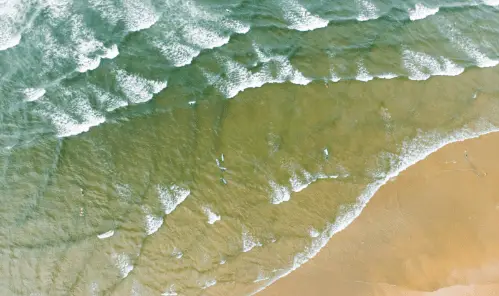Beach fishing (also known as surf fishing) is a popular form of angling that involves casting a fishing line from the shore into the ocean. It can be a great way to catch a variety of fish species, including striped bass, bluefish, and red drum. One of the key factors to consider when surf fishing is how far to cast your line. In this article, we’ll discuss some tips and techniques for determining the best casting distance when surf fishing.
What I’ve found, is that you should really focus on where to cast, and not how far. It’s not always best to cast as far out as you possibly can. The fish are usually closer to the beach than you think.
Factors to Consider
Several factors can influence where should cast when fishing from the beach. These include:
- Species of fish: Different fish species may prefer different water depths or distances from shore. For example, striped bass may be found in deeper water, while bluefish may be closer to shore.
- Tide and current: The strength and direction of the tide and current can affect how far your cast will travel, as well as where the fish are located.
- Wind direction and speed: The wind can also affect your casting distance, as well as the direction and speed of the current.
- Structure and depth: Underwater structures such as sandbars, jetties, and drop-offs can affect where the fish are located and how far you need to cast to reach them.
Techniques for Determining Casting Distance and Location
There are several techniques you can use to determine the best casting distance when surf fishing:
Read the beach at low tide
Reading the beach is essential for successful surf fishing because it allows you to identify areas where fish are likely to be feeding or traveling. By understanding the layout of the beach, you can determine where sandbars, troughs, channels, and other features are located, and target those areas with your bait or lure.

For example, sandbars are often prime locations for feeding fish, as they provide shelter and food sources such as baitfish and crustaceans. By identifying sandbars at low tide, you can cast your bait or lure towards these areas and increase your chances of catching fish.
Troughs, on the other hand, are areas where the water is deeper between two sandbars. These areas are often used by larger fish as a highway to travel along the beach. By casting your bait or lure into the trough, you may be able to catch these larger fish as they move along the beach.
Experiment with different distances
Another approach is to experiment with different casting distances until you find the sweet spot. Start by casting closer to shore and gradually work your way out until you find the depth and distance where the fish are biting.
You may need to cast your bait further out to reach the fish. One tip for casting farther when surf fishing is to use a longer fishing rod. A longer rod will give you more leverage and allow you to cast with greater force and distance. If you’re looking to cast farther, check out our list of the best rods for long distance casting.

Look for signs of fish activity: Watch for signs of fish activity, such as baitfish jumping out of the water or birds diving into the water. These can be indications that predatory fish (the kind you’re looking hook) are nearby.
Observe other anglers
One way to get a sense of how far to cast is to observe other anglers who are fishing in the same area. Take note of how far they are casting and whether they are having any success.
Wrapping up
When surf fishing, it is important to cast where the fish are likely to be feeding or traveling. Sandbars, troughs, areas near structure, and rip currents are all good places to target. A longer fishing rod and a heavy enough weight or sinker can help you achieve maximum distance in your cast.
The distance you should cast depends on a variety of factors such as tide and water depth, so pay attention to the conditions and adjust your casting strategy accordingly. Experiment with different depths, distances, and bait/lure presentations until you find what works best for the conditions and the fish you’re targeting.

Hello! My name is Tim and I’ve been fishing for over 30 years. I’ve learned a lot about fishing during that time and I love sharing that knowledge with others. I’m also a member of the International Game Fish Association (IGFA). Thanks for checking out the site!
